Determination of Fractional Vegetation Cover Threshold Based on the Integrated Synergy–Supply Capacity of Ecosystem Services
Abstract
1. Introduction
2. Materials and Methods
2.1. Research Area
2.2. Data Sources and Preprocessing
2.3. Study Methods
2.3.1. Methods for Assessing Ecosystem Services
2.3.2. Assessing Ecosystem Services Integrated Synergy–Supply Capacity
2.3.3. Quantifying Fractional Vegetation Cover
2.3.4. Trend Analysis Methods
2.3.5. Analyzing the Spatial Relationship Between the Fractional Vegetation Cover and the Integrated Synergy–Supply Capacity of Ecosystem Services
2.3.6. Determining the Nonlinear Relationship Between the Fractional Vegetation Cover and the Integrated Synergy–Supply Capacity of Ecosystem Services and Determining the Fractional Vegetation Cover Threshold
3. Results
3.1. Spatial Relationship Between the Fractional Vegetation Cover and the Integrated Synergy–Supply Capacity of Ecosystem Services
3.2. Determination of Fractional Vegetation Cover Constraint Line and Threshold Based on the Integrated Synergy–Supply Capacity of Ecosystem Services
4. Discussion
4.1. Nonlinear Constraint and Threshold Effect of Fractional Vegetation Cover on the Integrated Synergy–Supply Capacity of Ecosystem Services
4.2. Methods for Determining Fractional Vegetation Cover Threshold
4.3. Determining the Fractional Vegetation Cover Threshold Offers Significant Reference for Ecological Management Practices
4.4. Limitations of This Study
5. Conclusions
Supplementary Materials
Author Contributions
Funding
Data Availability Statement
Conflicts of Interest
References
- Holdren, J.P.; Ehrlich, P.R. Human population and the global environment. Am. Sci. 1974, 62, 282–292. Available online: http://www.jstor.org/stable/27844882 (accessed on 16 September 2023). [PubMed]
- Costanza, R.; d’Arge, R.; de Groot, R.; Farber, S.; Grasso, M.; Hannon, B.; Limburg, K.; Naeem, S.; O’Neill, R.V.; Paruelo, J.; et al. The value of the world’s ecosystem services and natural capital. Nature 1997, 387, 253–260. [Google Scholar] [CrossRef]
- Bennett, E.M.; Peterson, G.D.; Gordon, L.J. Understanding relationships among multiple ecosystem services. Ecol. Lett. 2009, 12, 1394–1404. [Google Scholar] [CrossRef] [PubMed]
- Bachelet, D.; Neilson, R.P.; Lenihan, J.M.; Drapek, R.J. Climate Change Effects on Vegetation Distribution and Carbon Budget in the United States. Ecosystems 2021, 4, 164–185. [Google Scholar] [CrossRef]
- Teixeira, G.M.; Figueiredo, P.H.; Salemi, L.F.; Ferraz, S.F.; Ranzini, M.; Arcova, F.C.; Cicco, V.; Rizzi, N.E. Regeneration of tropical montane cloud forests increases water yield in the Brazilian Atlantic Forest. Ecohydrology 2021, 14, e2298. [Google Scholar] [CrossRef]
- Wang, N.; Bi, H.; Peng, R.; Zhao, D.; Liu, Z. Synergistic enhancement of regeneration capacity and ecological functions of Robinia pseudoacacia L. plantations in the Loess Plateau. Catena 2024, 243, 108226. [Google Scholar] [CrossRef]
- Gitelson, A.A.; Kaufman, Y.J.; Stark, R.; Rundquist, D. Novel algorithms for remote estimation of vegetation fraction. Remote Sens. Environ. 2002, 80, 76–87. [Google Scholar] [CrossRef]
- Gao, Y.; Zhong, B.; Yue, H.; Wu, B.; Cao, S. A degradation threshold for irreversible loss of soil productivity: A long-term case study in China. J. Appl. Ecol. 2011, 48, 1145–1154. [Google Scholar] [CrossRef]
- Zhang, K.; Lv, Y.; Fu, B.; Yin, L.; Yu, D. The effects of vegetation coverage changes on ecosystem service and their threshold in the Loess Plateau. Acta Geogr. Sin. 2020, 75, 949–960. [Google Scholar] [CrossRef]
- Qiu, H.; Zhang, J.; Han, H.; Cheng, X.; Kang, F. Study on the impact of vegetation change on ecosystem services in the Loess Plateau, China. Ecol. Indic. 2023, 154, 110812. [Google Scholar] [CrossRef]
- Zhu, M.; Zhou, Z.; Wu, X.; Liu, R.; Zheng, J.; Wang, J.; Wan, J. Response of vegetation carbon sequestration potential to the effectiveness of vegetation restoration in karst ecologically fragile areas in Guizhou, southwest China. Ecol. Indic. 2024, 158, 111495. [Google Scholar] [CrossRef]
- Munyon, J.W.; Flitcroft, R.L. Evaluating floodplain vegetation after valley-scale restoration with unsupervised classification of National Agriculture Imagery Program data in semi-arid environments. J. Am. Water Resour. Assoc. 2025, 61, e13245. [Google Scholar] [CrossRef]
- Ram, M.; Sheaves, M.; Waltham, N.J. Tracking the long-term vegetation and soil characteristics of restored mangroves: A case study from Guyans’ coast. Restor. Ecol. 2024, 32, e14170. [Google Scholar] [CrossRef]
- Raudsepp-Hearne, C.; Peterson, G.D.; Bennett, E.M. Ecosystem service bundles for analyzing tradeoffs in diverse landscapes. Proc. Natl. Acad. Sci. USA 2010, 107, 5242–5247. [Google Scholar] [CrossRef]
- Bukvareva, E.; Zamolodchikov, D.; Kraev, G.; Grunewald, K.; Narykov, A. Supplied, demanded and consumed ecosystem services: Prospects for national assessment in Russia. Ecol. Indic. 2017, 78, 351–360. [Google Scholar] [CrossRef]
- Dang, H.; Li, J.; Zhang, Y.; Zhou, Z. Evaluation of the equity and regional management of some urban green space ecosystem services: A case study of main urban area of Xi’an city. Forests 2021, 12, 813. [Google Scholar] [CrossRef]
- Foudi, S.; Spadaro, J.V.; Chiabai, A.; Polanco-Martinez, J.M.; Neumann, M.B. The climatic dependencies of urban ecosystem services from green roofs: Threshold effects and non-linearity. Ecosyst. Serv. 2017, 24, 223–233. [Google Scholar] [CrossRef]
- Peng, J.; Tian, L.; Liu, Y.; Zhao, M.; Hu, Y.; Wu, J. Ecosystem services response to urbanization in metropolitan areas: Thresholds identification. Sci. Total Environ. 2017, 607, 706–714. [Google Scholar] [CrossRef]
- Shen, J.; Li, S.; Liu, L.; Liang, Z.; Wang, Y.; Wang, H.; Wu, S. Uncovering the relationships between ecosystem services and social-ecological drivers at different spatial scales in the Beijing-Tianjin-Hebei region. J. Clean. Prod. 2020, 290, 125193. [Google Scholar] [CrossRef]
- Jiang, C.; Wang, X.; Zhang, H.; Labzovskii, L.; Wang, J.; Liu, T. Re-orienting ecological restoration in degraded drylands for a more sustainable soil–water relationship: Non-linear boundary of limited water resources in combating soil loss. J. Arid Environ. 2019, 167, 87–100. [Google Scholar] [CrossRef]
- Ruan, J.; Li, Z.; Zhang, X.; Jian, X.; Wang, D. Optimal vegetation coverage from the perspective of ecosystem services in the Qilian Mountains. Environ. Res. Commun. 2024, 6, 115023. [Google Scholar] [CrossRef]
- Zhao, Z.; Dai, E. Vegetation cover dynamics and its constraint effect on ecosystem services on the Qinghai-Tibet Plateau under ecological restoration projects. J. Environ. Manag. 2024, 356, 120535. [Google Scholar] [CrossRef]
- Feng, Z.; Jin, X.; Chen, T.; Wu, J. Understanding trade-offs and synergies of ecosystem services to support the decision-making in the Beijing-Tianjin-Hebei region. Land Use Policy 2021, 106, 105446. [Google Scholar] [CrossRef]
- Cord, A.F.; Bartkowski, B.; Beckmann, M.; Dittrich, A.; Hermans-Neumann, K.; Kaim, A.; Lienhoop, N.; Locher-Krause, K.; Priess, J.; Schröter-Schlaack, C.; et al. Towards systematic analyses of ecosystem service trade-offs and synergies: Main concepts, methods and the road ahead. Ecosyst. Serv. 2017, 28, 264–272. [Google Scholar] [CrossRef]
- Deng, G.; Jiang, H.; Ma, S.; Wen, Y.; He, C.; Sheng, L.; Gu, D. How water–energy–food services and their interactions change along multiple environmental gradients. Agric. Water Manag. 2025, 309, 109339. [Google Scholar] [CrossRef]
- Zhang, L.; Lei, J.; Chen, Z.; Zhou, P.; Wu, T.; Chen, X.; Li, Y.; Pan, X. Spatiotemporal Differentiation and Trade-offs and Synergies of Ecosystem Services in Tropical Island Basins: A Case Study of Three Major Basins of Hainan Island. J. Clean. Prod. 2025, 490, 144798. [Google Scholar] [CrossRef]
- Chen, T.; Wang, Y.; Zeng, X.; Wang, Q. Characteristics and the constraint relationship between ecosystem services and vegetation coverage in the Southwest China. Acta Ecol. Sin. 2023, 43, 2253–2270. [Google Scholar] [CrossRef]
- Xun, B.; Zheng, Y.; Fan, R.; Hao, R.F.; Liu, B.Y. Assessment of trade-off/synergy relationships between ecosystem services and identification of ecological restoration thresholds. Acta Ecol. Sin. 2024, 44, 7431–7444. [Google Scholar] [CrossRef]
- Zheng, T.; Zhou, Z.; Zou, Y.; Pulatov, B.; Biswas, A. Analysis of spatial and temporal characteristics and spatial flow process of soil conservation service in Jinghe basin of China. Sustainability 2021, 13, 1794. [Google Scholar] [CrossRef]
- Ouyang, Z.; Zheng, H.; Xiao, Y.; Polasky, S.; Liu, J.; Xu, W.; Wang, Q.; Zhang, L.; Xiao, Y.; Rao, E.M.; et al. Improvements in ecosystem services from investments in natural capital. Science 2016, 352, 1455–1459. [Google Scholar] [CrossRef]
- Feng, X.; Fu, B.; Piao, S.; Wang, S.; Ciais, P.; Zeng, Z.; Li, Y.; Jiang, X.; Wu, B. Revegetation in China’s Loess Plateau is approaching sustainable water resource limits. Nat. Clim. Chang. 2016, 6, 1019–1022. [Google Scholar] [CrossRef]
- Bradford, J.B.; D’Amato, A. Recognizing trade-offs in multi-objective land management. Front. Ecol. Environ. 2012, 10, 210–216. [Google Scholar] [CrossRef]
- Ivits, E.; Cherlet, M.; Sommer, S.; Mehl, W. Addressing the complexity in non- linear evolution of vegetation phenological change with time-series of remote sensing images. Ecol. Indic. 2013, 26, 49–60. [Google Scholar] [CrossRef]
- Imukova, K.; Ingwersen, J.; Streck, T. Determining the spatial and temporal dynamics of the green vegetation fraction of croplands using high-resolution RapidEye satellite images. Agric. For. Meteorol. 2015, 206, 113–123. [Google Scholar] [CrossRef]
- Ali, R.; Kuriqi, A.; Abubaker, S.; Kisi, O. Long-term trends and seasonality detection of the observed flow in Yangtze River using Mann-Kendall and Sen’s innovative trend method. Water 2019, 11, 1855. [Google Scholar] [CrossRef]
- Anselin, L. Local indicators of spatial association-LISA. Geog. Anal. 1995, 27, 93–115. [Google Scholar] [CrossRef]
- Hao, R.F.; Yu, D.Y.; Wu, J.G. Relationship between paired ecosystem services in the grassland and agro-pastoral transitional zone of China using the constraint line method. Agr. Ecosyst. Environ. 2017, 240, 171–181. [Google Scholar] [CrossRef]
- Fong, Y.; Huang, Y.; Gilbert, P.B.; Permar, S.R. chngpt: Threshold regression model estimation and inference. BMC Bioinform. 2017, 18, 454. [Google Scholar] [CrossRef]
- Gauthier, J.; Wu, Q.V.; Gooley, T.A. Cubic splines to model relationships between continuous variables and outcomes: A guide for clinicians. Bone Marrow Transplant. 2020, 55, 675–680. [Google Scholar] [CrossRef]
- Li, D.; Cao, W.; Dou, Y.; Wu, S.; Liu, J.; Li, S. Non-linear effects of natural and anthropogenic drivers on ecosystem services: Integrating thresholds into conservation planning. J. Environ. Manag. 2022, 321, 116047. [Google Scholar] [CrossRef]
- Zhou, J.; Fu, B.; Gao, G.; Lü, Y.; Liu, Y.; Lü, N.; Wang, S. Effects of precipitation and restoration vegetation on soil erosion in a semi-arid environment in the Loess Plateau, China. Catena 2016, 137, 1–11. [Google Scholar] [CrossRef]
- Gong, J.; Ma, Z.; Hu, C.; He, L.; Lei, J. Study on the Constraint Effect of Vegetation on Ecosystem Services in the Yellow River Basin. Forests 2024, 15, 1771. [Google Scholar] [CrossRef]
- Ma, M.; Li, Q.; Wang, J.; Wang, Y.; Zhang, M. A Review of Canopy Interception of Forest Ecosystems in Drylands of China. J. Northwest For. Univ. 2024, 39, 1–13. [Google Scholar] [CrossRef]
- Yang, C.; Zhang, X.; Ni, H.; Gai, X.; Huang, Z.; Du, X.; Zhong, Z. Soil carbon and associated bacterial community shifts driven by fine root traits along a chronosequence of Moso bamboo (Phyllostachys edulis) plantations in subtropical China. Sci. Total Environ. 2021, 752, 142333. [Google Scholar] [CrossRef]
- Augusto, L.; Boča, A. Tree functional traits, forest biomass, and tree species diversity interact with site properties to drive forest soil carbon. Nat. Commun. 2022, 13, 1097. [Google Scholar] [CrossRef] [PubMed]
- Guo, M.; Wang, W.; Kang, H.; Yang, B. Changes in soil properties and erodibility of gully heads induced by vegetation restoration on the Loess Plateau, China. J. Arid Land 2018, 10, 712–725. [Google Scholar] [CrossRef]
- Wang, G.; Liu, G.; Li, C. Effects of changes in alpine grassland vegetation cover on hillslope hydrological processes in a permafrost watershed. J. Hydrol. 2012, 444, 22–33. [Google Scholar] [CrossRef]
- Chen, H.; Zhang, X.; Abla, M.; Lü, D.; Yan, R.; Ren, Q.; Ren, Z.; Yang, Y.; Zhao, W.; Lin, P.; et al. Effects of vegetation and rainfall types on surface runoff and soil erosion on steep slopes on the Loess Plateau, China. Catena 2018, 170, 141–149. [Google Scholar] [CrossRef]
- Hua, F.; Bruijnzeel, L.A.; Meli, P.; Martin, P.A.; Zhang, J.; Nakagawa, S.; Miao, X.; Wang, W.; Mcevoy, C.; Peña-Arancibia, J.L.; et al. The biodiversity and ecosystem service contributions and trade-offs of forest restoration approaches. Science 2022, 376, 839–844. [Google Scholar] [CrossRef]
- Xiao, T.; Li, P.; Fei, W.; Wang, J. Effects of vegetation roots on the structure and hydraulic properties of soils: A perspective review. Sci. Total Environ. 2023, 906, 167524. [Google Scholar] [CrossRef]
- Wen, X.; Théau, J. Spatiotemporal analysis of water-related ecosystem services under ecological restoration scenarios: A case study in northern Shaanxi, China. Sci. Total Environ. 2020, 720, 137477. [Google Scholar] [CrossRef] [PubMed]
- Chen, Y.; Wang, K.; Fu, B.; Wang, Y.; Tian, H.; Wang, Y.; Zhang, Y. 65% cover is the sustainable vegetation threshold on the Loess Plateau. Environ. Sci. Ecotechnol. 2024, 22, 100442. [Google Scholar] [CrossRef]
- Fu, B.J.; Wang, S.; Liu, Y.; Liu, J.B.; Liang, W.; Miao, C.Y. Hydrogeomorphic ecosystem responses to natural and anthropogenic changes in the Loess Plateau of China. Annu. Rev. Earth Planet. Sci. 2017, 45, 223–243. [Google Scholar] [CrossRef]
- Shi, Y.; Tonda, A.; Accatino, F. Handling ecosystem service trade-offs: The importance of the spatial scale at which no-loss constraints are posed. Landsc. Ecol. 2023, 38, 1163–1175. [Google Scholar] [CrossRef]
- Ficetola, G.F.; Denoel, M. Ecological thresholds: An assessment of methods to identify abrupt changes in species-habitat relationships. Ecography 2009, 32, 1075–1084. [Google Scholar] [CrossRef]
- Pittman, S.D.; Turnblom, E.C. A study of self-thinning using coupled allometric equations: Implications for coastal Douglas-fir stand dynamics. Can. J. For. Res. 2003, 33, 1661–1669. [Google Scholar] [CrossRef]
- Webb, R. Use of the boundary line in the analysis of biological data. Hortic. Sci. 1972, 47, 309–319. [Google Scholar] [CrossRef]
- Mills, A.J.; Fey, M.V.; Donaldson, J.; Todd, S.; Theron, L. Soil infiltrability as a driver of plant cover and species richness in the semi-arid Karoo, South Africa. Plant Soil 2009, 320, 321–332. [Google Scholar] [CrossRef]
- Medinski, T.V.; Mills, A.J.; Esler, K.J.; Schmiedel, U.; Jürgens, N. Do soil properties constrain species richness? Insights from boundary line analysis across several biomes in south western Africa. J. Arid Environ. 2010, 74, 1052–1060. [Google Scholar] [CrossRef]
- Li, Z.; Guan, D.; Zhou, L.; Zhang, Y. Constraint relationship of ecosystem services in the Yangtze River Economic Belt, China. Environ. Sci. Pollut. 2021, 29, 12484–12505. [Google Scholar] [CrossRef]
- Hong, G.; Liu, S.; Liu, W.; Wu, X. Nonlinear trade-off relationship and critical threshold between ecosystem services and climate resilience for sustainable urban development. Sustain. Cities Soc. 2024, 103, 105253. [Google Scholar] [CrossRef]
- Yang, M.; Chen, Y.; Yang, Y.; Yan, Y. Nonlinear relationship and threshold-based zones between ecosystem service supply-demand ratio and land use intensity: A case study of the Beijing-Tianjin-Hebei region, China. J. Clean. Prod. 2024, 481, 144148. [Google Scholar] [CrossRef]
- Li, J.; Pei, Y.; Zhao, S.; Xiao, R.; Sang, X.; Zhang, C. A Review of Remote Sensing for Environmental Monitoring in China. Remote Sens. 2020, 12, 1130. [Google Scholar] [CrossRef]
- Wang, Y.; Yan, W.; Han, X.; Pan, F.; Cheng, L.; Liu, W. Changes in deep soil water content in the process of large-scale apple tree planting on the Loess Tableland of China. Forests 2021, 12, 123. [Google Scholar] [CrossRef]
- Hu, J.; Lü, Y.; Fu, B.; Comber, A.J.; Harris, P. Quantifying the effect of ecological restoration on runoff and sediment yields: A meta-analysis for the Loess Plateau of China. Prog. Phys. Geog. 2017, 41, 753–774. [Google Scholar] [CrossRef]
- Cao, S.X.; Chen, L.; Shankman, D.; Wang, C.M.; Wang, X.B.; Zhang, H. Excessive reliance on afforestation in China’s arid and semi-arid regions: Lessons in ecological restoration. Earth Sci. Rev. 2011, 104, 240–245. [Google Scholar] [CrossRef]
- Qiu, J.; Huang, T.; Yu, D. Evaluation and optimization of ecosystem services under different land use scenarios in a semiarid landscape mosaic. Ecol. Indic. 2022, 135, 108516. [Google Scholar] [CrossRef]
- Ivanova, N. Global overview of the application of the Braun-Blanquet approach in research. Forests 2024, 15, 937. [Google Scholar] [CrossRef]
- Xu, L.; He, N.; Yu, G. A dataset of carbon density in Chinese terrestrial ecosystems (2010s). China Sci. Data 2019, 4, 86–92. [Google Scholar] [CrossRef]
- Yang, J.X.; Bao, P.; Zhang, D.G. Spatio-temporal evolution of carbon stocks in the Yellow River Basin based on InVEST and CA-Markov models. Chin. J. Eco-Agric. 2021, 29, 1018–1029. [Google Scholar] [CrossRef]
- Chen, X.; Yu, L.; Hou, S.; Liu, T.; Li, X.; Li, Y.; Du, Z.; Li, C.; Wu, H.; Gao, G.; et al. Unraveling carbon stock dynamics and their determinants in China’s Loess Plateau over the past 40 years. Ecol. Indic. 2024, 159, 111760. [Google Scholar] [CrossRef]
- Chen, G.; Yang, Y.; Liu, L.; Li, X.; Zhao, Y.; Yuan, Y. Research review on total belowground carbon allocation in forest ecosystems. J. Subtrop. Resour. Environ. 2007, 2, 34–42. [Google Scholar] [CrossRef]
- Peng, S.; Gang, C.; Cao, Y.; Chen, Y. Assessment of climate change trends over the loess plateau in China from 1901 to 2100. Int. J. Climatol. 2017, 38, 2250–2264. [Google Scholar] [CrossRef]
- Peng, S.Z.; Ding, Y.X.; Wen, Z.M.; Chen, Y.M.; Cao, Y.; Ren, J.Y. Spatiotemporal change and trend analysis of potential evapotranspiration over the Loess Plateau of China during 2011–2100. Agric. For. Meteorol. 2017, 233, 183–194. [Google Scholar] [CrossRef]
- Peng, S. 1-km Monthly Mean Temperature Dataset for China (1901–2023). National Tibetan Plateau/Third Pole Environment Data Center, China. 2019. Available online: https://doi.org/10.11888/Meteoro.tpdc.270961 (accessed on 14 January 2024).
- Peng, S.Z.; Ding, Y.X.; Liu, W.Z.; Li, Z. 1 km monthly temperature and precipitation dataset for China from 1901 to 2017. Earth Syst. Sci. Data 2019, 11, 1931–1946. [Google Scholar] [CrossRef]
- Ding, Y.X.; Peng, S.Z. Spatiotemporal trends and attribution of drought across China from 1901–2100. Sustainability 2020, 12, 477. [Google Scholar] [CrossRef]
- Peng, S. 1-km Monthly Precipitation Dataset for China (1901–2023). National Tibetan Plateau/Third Pole Environment Data Center, China. 2020. Available online: https://doi.org/10.5281/zenodo.3114194 (accessed on 26 December 2023).
- Fischer, G.; Nachtergaele, F.O.; Prieler, S.; Velthuizen, H.V.; Verelst, L.; Wiberg, D. Global Agro-ecological Zones Assessment for Agriculture (GAEZ 2008). IIASA, Laxenburg, Austria and FAO, Rome, Italy. 2008. Available online: https://www.fao.org/soils-portal/data-hub/soil-maps-and-databases/harmonized-world-soil-database-v12/en/ (accessed on 28 October 2023).
- NASA JPL. NASADEM Merged DEM Global 1 arc second V001 [Data Set]. NASA EOSDIS Land Processes Distributed Active Archive Center. 2020. Available online: https://doi.org/10.5067/MEaSUREs/NASADEM/NASADEM_HGT.001 (accessed on 19 October 2023).
- Zhang, Y.; Shi, F.; Zhang, Y.; Li, M.; Cui, G.; Liu, Z. Temporal and Spatial Changes and Driving Factors of Soil Erosion in the Middle Reaches of the Yellow River. Res. Soil Water Conserv. 2023, 30, 1–12. [Google Scholar] [CrossRef]
- Xu, J.; Liu, H. Assessment and prediction of ecosystem services trade-offs and synergies relationships in Gansu Province. China Environ. Sci. 2024, 44, 1863–1874. [Google Scholar] [CrossRef]
- Cai, C.; Ding, S. Study of applying USLE and geographical information system IDRISI to predict soil erosion in small watershed. J. Soil Water Conserv. 2000, 14, 19–24. [Google Scholar] [CrossRef]
- Zhou, W.; Liu, G.; Pan, J.; Feng, X. Distribution of available soil water capacity in China. J. Geog. Sci. 2005, 15, 3–12. [Google Scholar] [CrossRef]
- Xue, J.; Li, Z.; Feng, Q.; Gui, J.; Zhang, B. Spatiotemporal variations of water conservation and its influencing factors in ecological barrier region, Qinghai-Tibet Plateau. J. Hydrol.-Reg. Stud. 2022, 42, 101164. [Google Scholar] [CrossRef]
- Ding, Y.X.; Peng, S.Z. Spatiotemporal change and attribution of potential evapotranspiration over China from 1901 to 2100. Theor. Appl. Climatol. 2021, 145, 79–94. [Google Scholar] [CrossRef]
- Peng, S. 1-km Monthly Potential Evapotranspiration Dataset for China (1901–2023). National Tibetan Plateau/Third Pole Environment Data Center, China. 2022. Available online: https://doi.org/10.11866/db.loess.2021.001 (accessed on 1 November 2023).
- Yan, F.; Shangguan, W.; Zhang, J.; Hu, B.F. Depth-to-bedrock map of China at a spatial resolution of 100 meters. Sci. Data 2020, 7, 2. [Google Scholar] [CrossRef]
- Yun, L.; Bi, H.; Ma, W. Distribution characteristics of Robinia pseudoacacia roots in silvopastoral system in the loess region of west Shanxi. J. Arid Land Resour. Environ. 2012, 26, 151–155. [Google Scholar] [CrossRef]
- Sun, T.; Wang, X.; Li, D.; Liu, X.; Wang, R.; Zhang, S. Changes in root biomass of grassland along the environmental gradient in the Loess Plateau. Acta Ecol. Sin. 2021, 41, 6234–6244. [Google Scholar] [CrossRef]
- Lan, Y.; Sun, T.; Li, W. Trade-offs and synergies of farmland ecosystem services in Loess Plateau: A case study of Longdong Region, Northwest China. Trans. Chin. Soc. Agric. Eng. 2023, 39, 236–244. [Google Scholar] [CrossRef]
- Zhao, Y.; Yu, Y.; Sun, B. Research on the Spatiotemporal Changes of Supply and Demand for Water Yield in Shanxi Province. J. Soil Water Conserv. 2023, 37, 126–133+144. [Google Scholar] [CrossRef]
- Natural Capital Project. InVEST 3.14.1 User’s Guide; Stanford University, University of Minnesota, Chinese Academy of Sciences, The Nature Conservancy, World Wildlife Fund, Stockholm Resilience Centre and the Royal Swedish Academy of Sciences: San Francisco, CA, USA, 2023. [Google Scholar]
- Chen, S.; Huang, Y.; Jin, Y. Spatiotemporal changes of habitat quality before and after the implementation of Grain for Green Project in the middle reaches of the Yellow River. Arid Zone Res. 2023, 40, 456–468. [Google Scholar] [CrossRef]
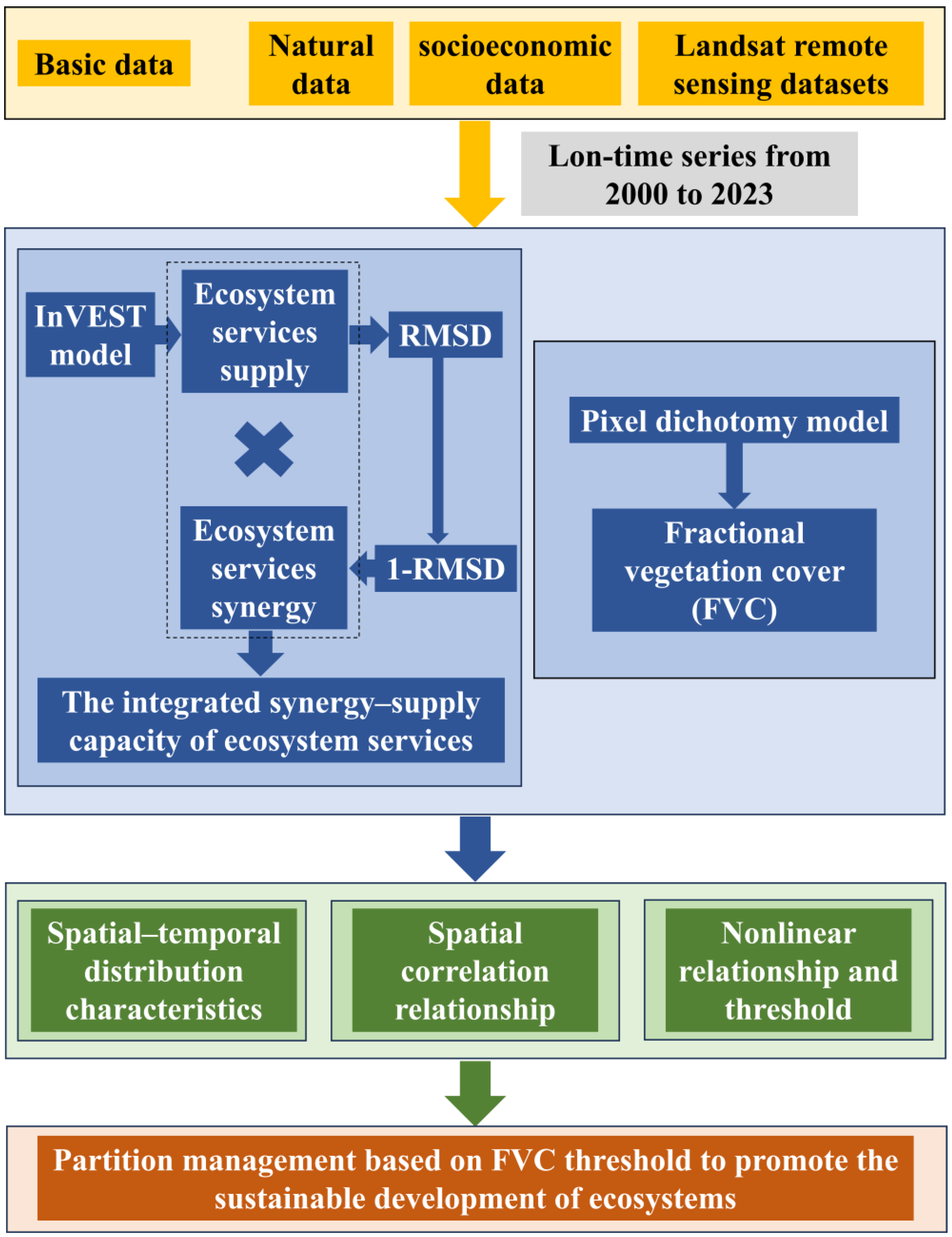
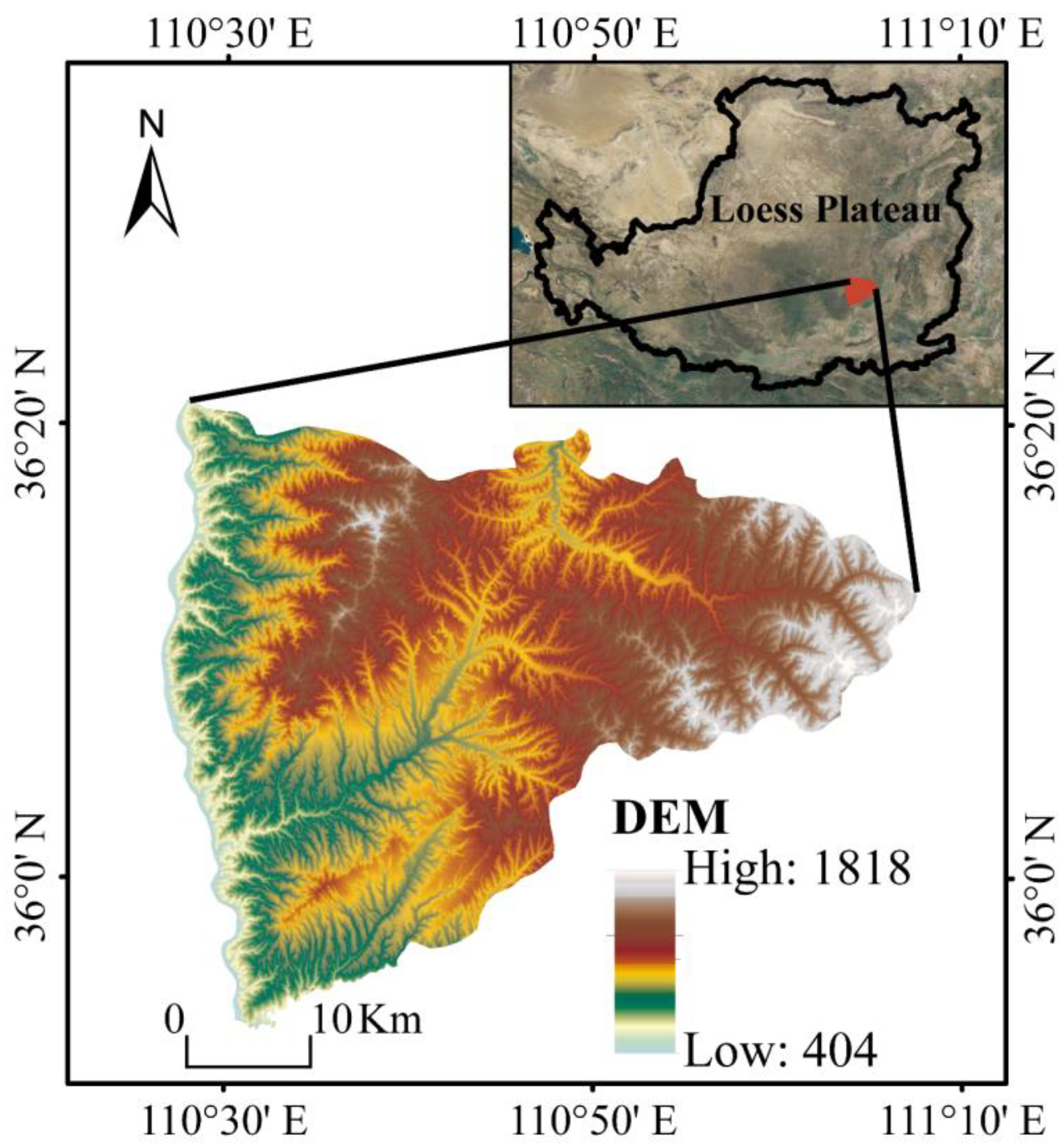
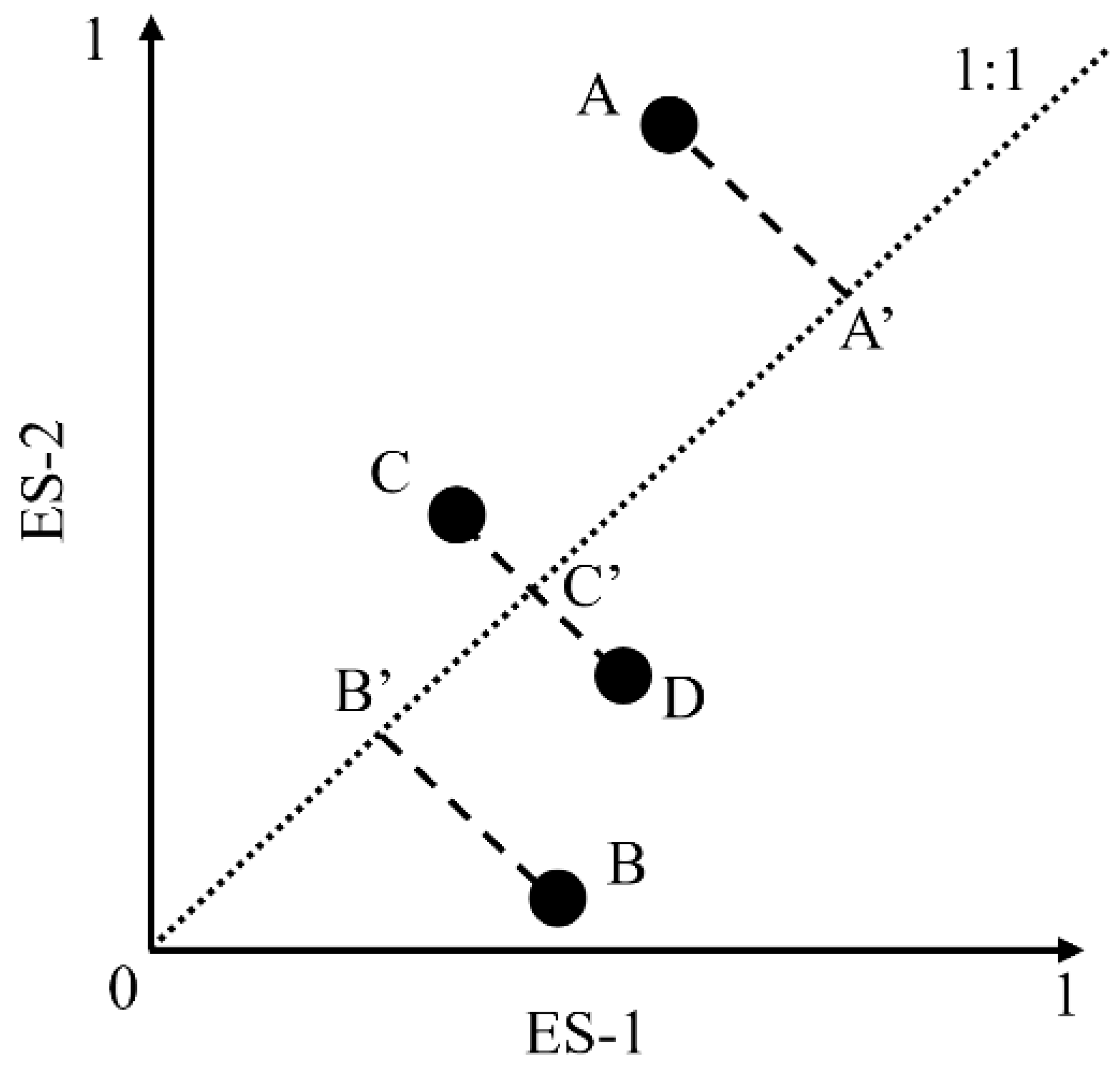
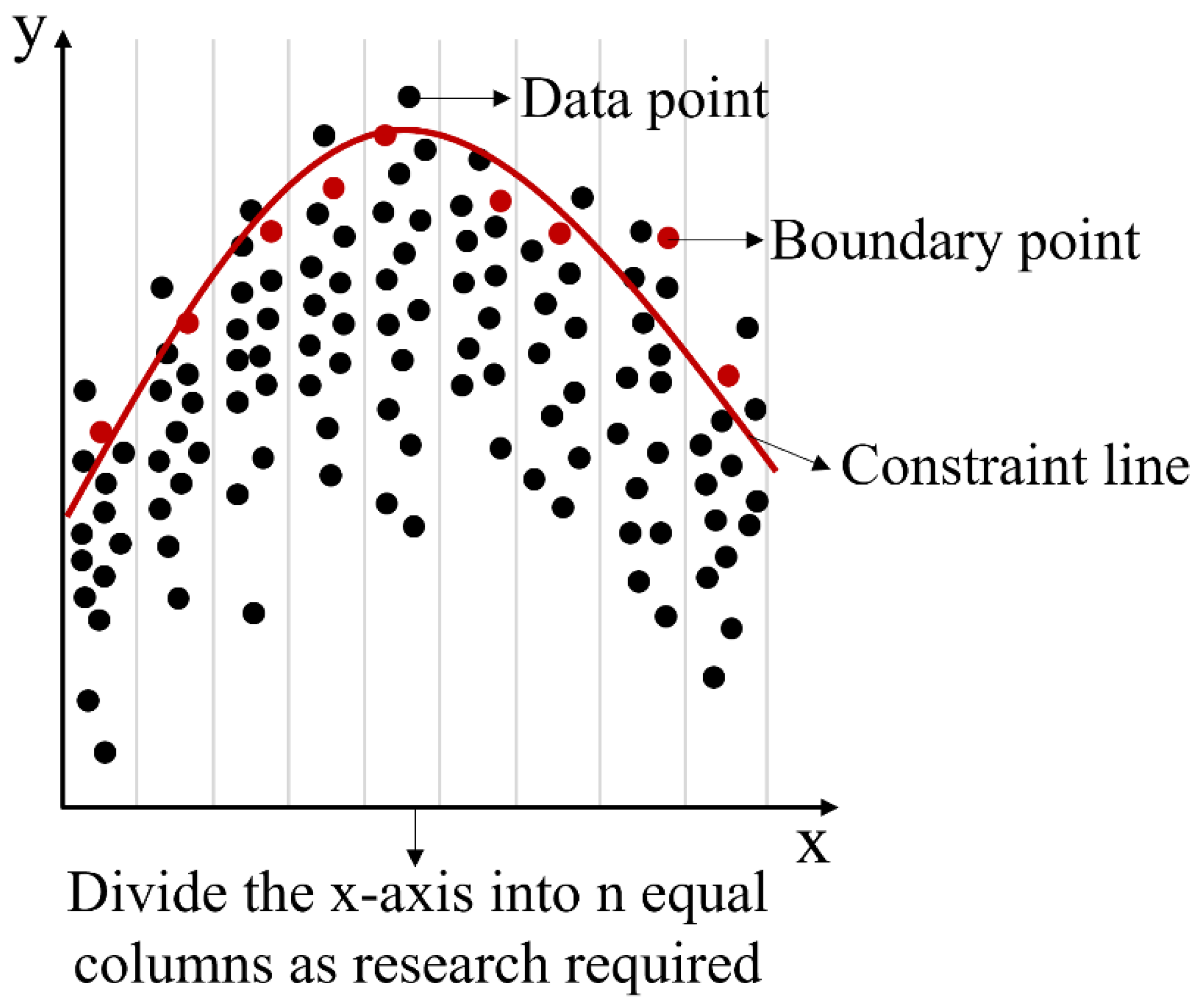
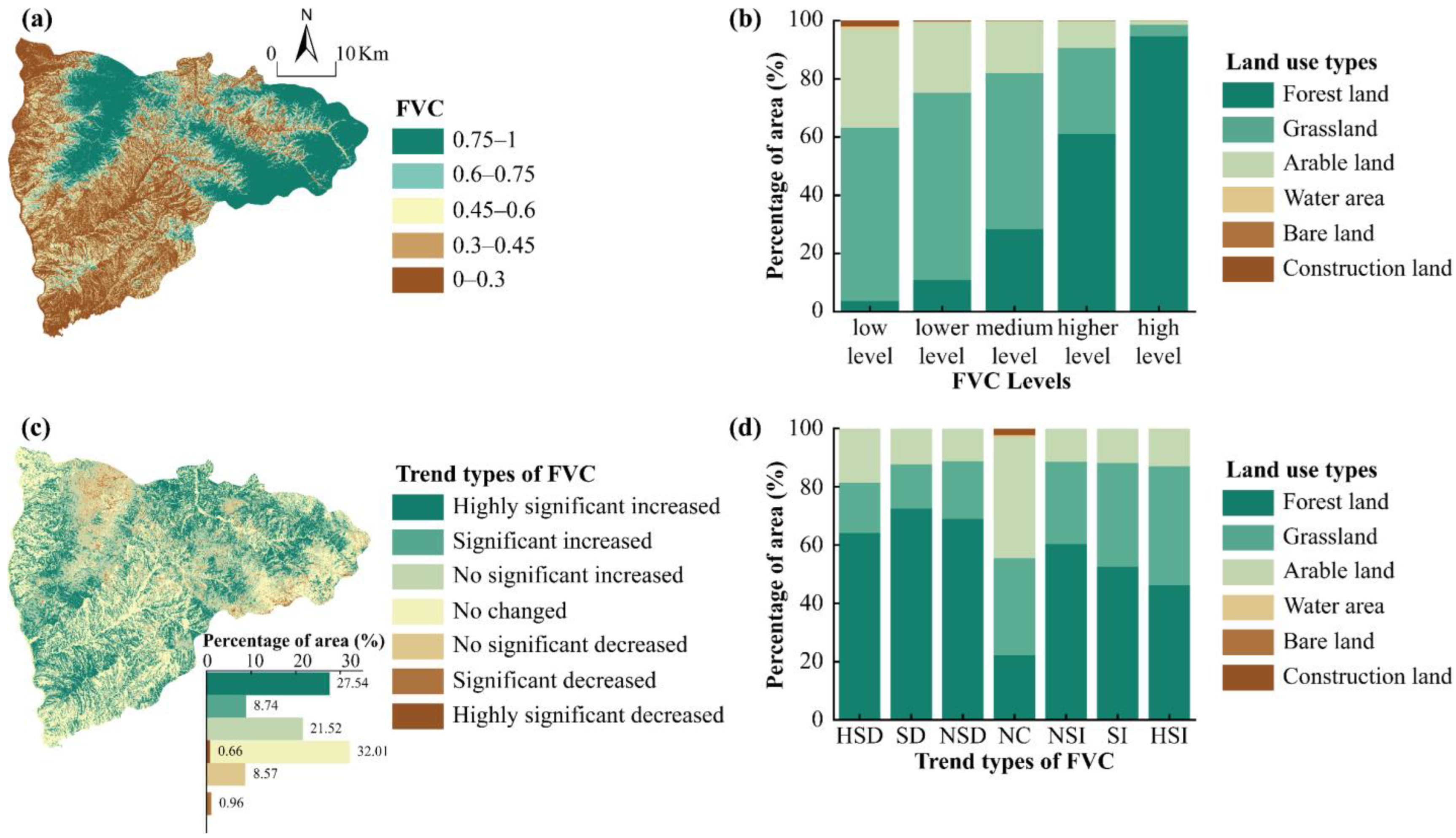
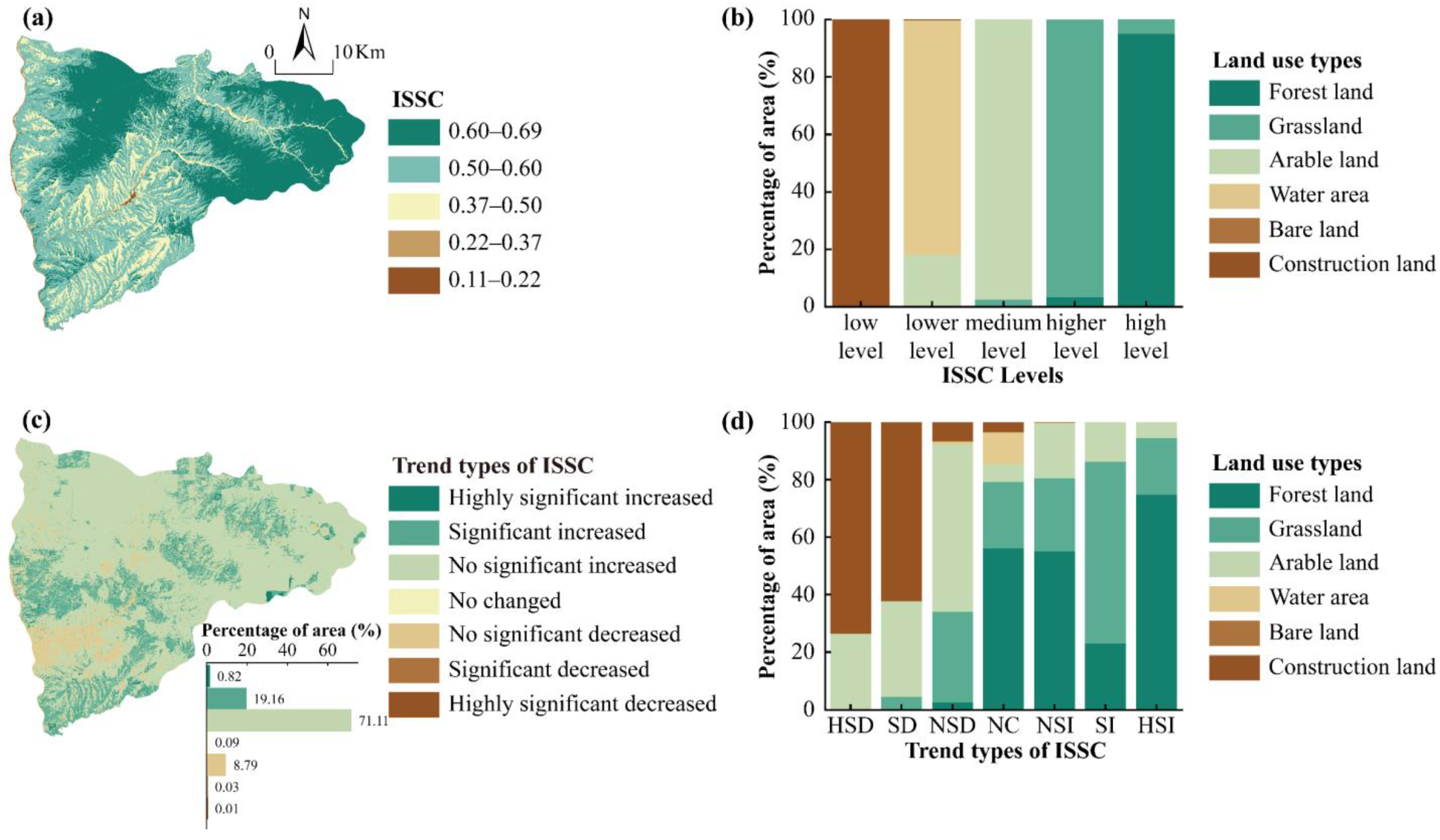
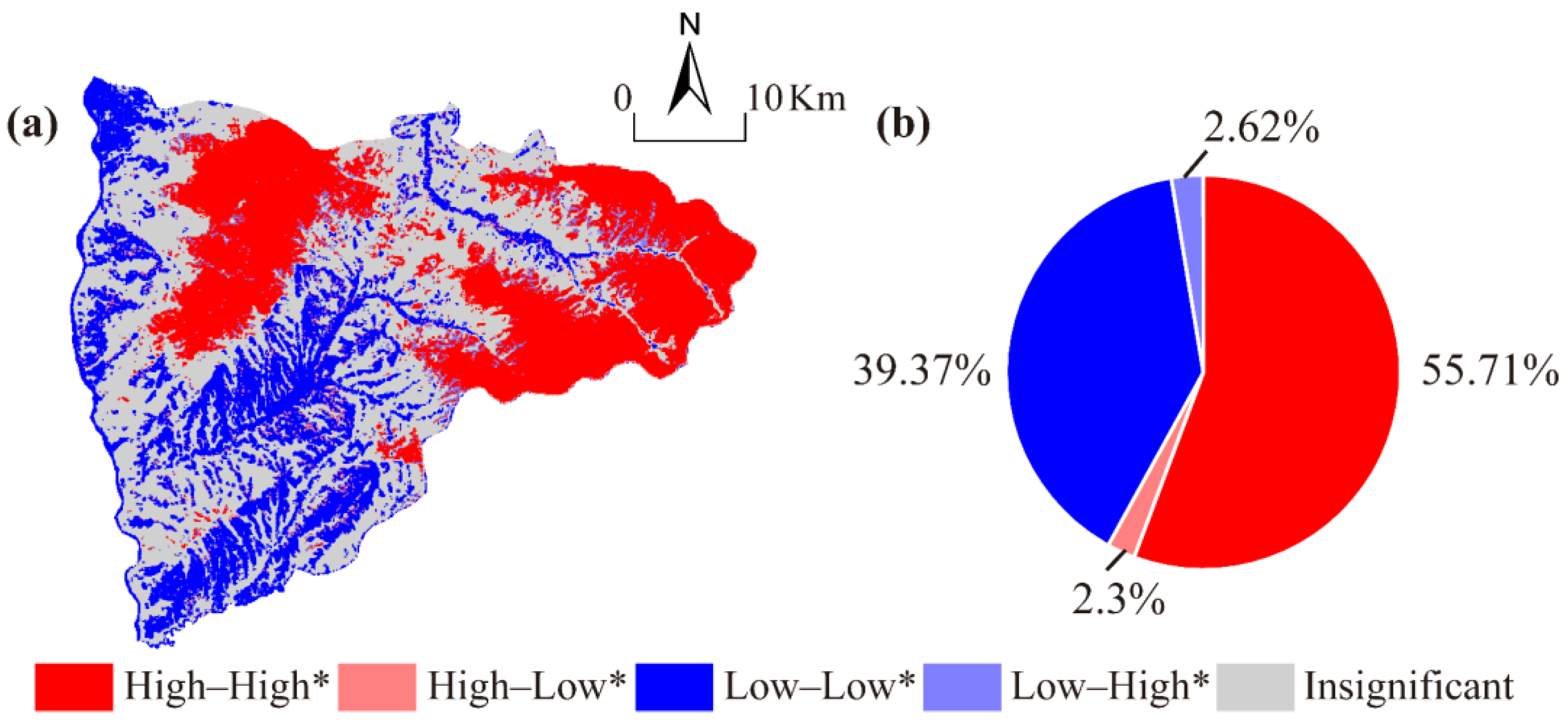
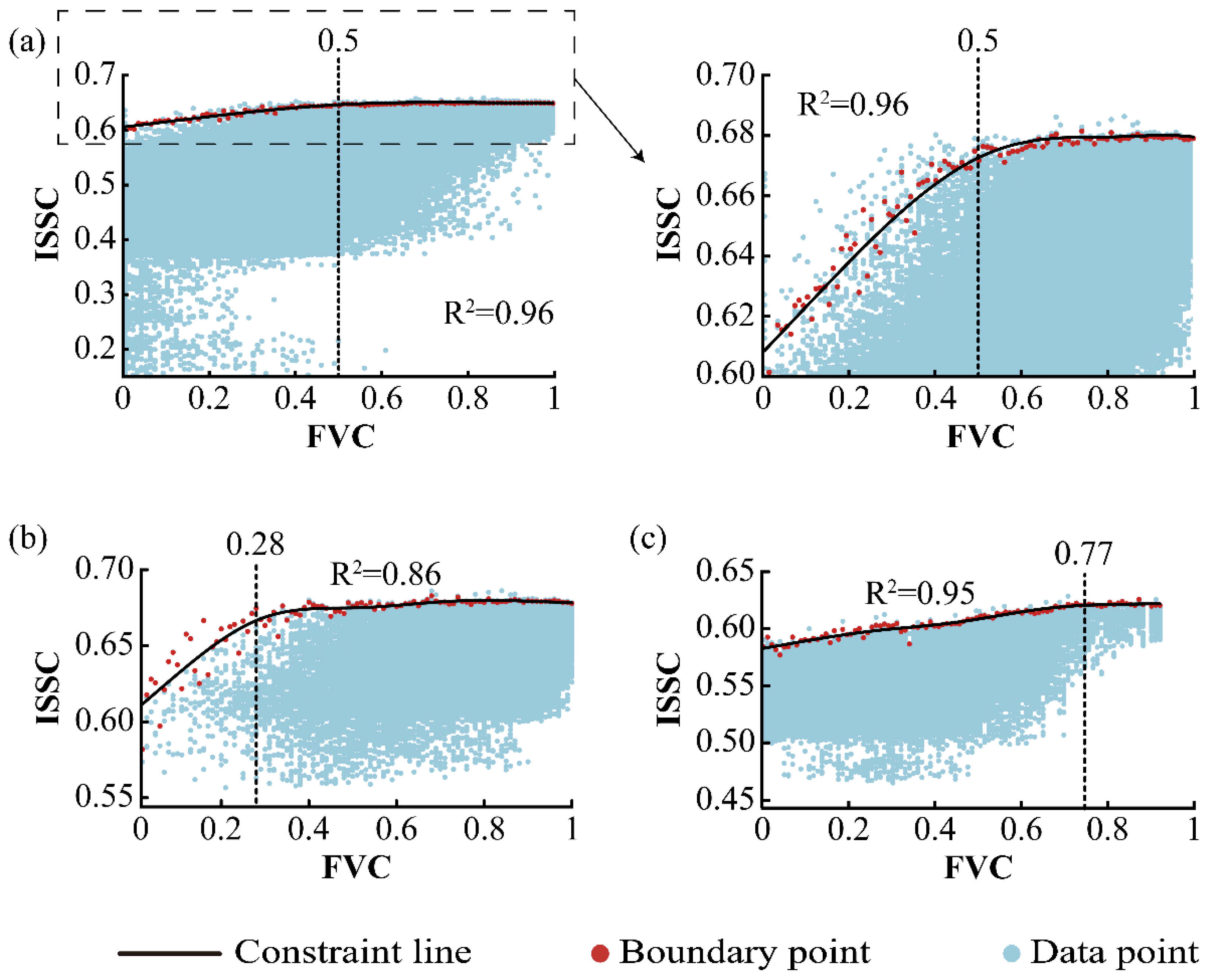
| Data Types | Format | Resolution | Data Source |
|---|---|---|---|
| Fractional vegetation cover (FVC) data | Raster | 30 m | Google Earth Engine platform (https://code.earthengine.google.com (accessed on 5 May 2024)) |
| Land use data | Raster | 30 m | Google Earth Engine platform (https://code.earthengine.google.com (accessed on 7 March 2024)) |
| Digital elevation model (DEM) | Raster | 30 m | National Aeronautics and Space Administration Digital Elevation Model (NASADEM) (https://lpdaac.usgs.gov/products/nasadem_hgtv001/ (accessed on 19 October 2023)) |
| Precipitation | Raster | 1 km | National Scientific Data Center for the Tibetan Plateau (https://data.tpdc.ac.cn/ (accessed on 26 December 2023)) |
| Temperature | Raster | 1 km | National Scientific Data Center for the Tibetan Plateau (https://cstr.cn/18406.11.Meteoro.tpdc.270961 (accessed on 14 January 2024)) |
| Potential evapotranspiration | Raster | 1 km | National Scientific Data Center for the Tibetan Plateau (https://data.tpdc.ac.cn/ (accessed on 1 November 2023)) |
| Soil data | Raster | 1 km | Harmonized World Soil Database (HWSD) (https://www.fao.org/soils-portal/data-hub/soil-maps-and-databases/harmonized-world-soil-database-v12/en/ (accessed on 28 October 2023)) |
| Depth to bedrock data | Raster | 100 m | Depth-to-bedrock map of China at resolution of 100 m (http://globalchange.bnu.edu.cn/research/cdtb.jsp (accessed on 28 October 2023)) |
| Road | Shapfile | - | OpenStreetMap (OSM) (https://www.openstreetmap.org/ (accessed on 29 October 2023)) |
| Ecosystem Services | Abbreviation | Calculation Formula |
|---|---|---|
| Carbon storage | CS | |
| Soil conservation | SC | |
| Water conservation | WC | |
| Habitat quality | HQ |
| Classification | Quantity of Segmentation Points | AIC Value |
|---|---|---|
| Regional | 3 | −793.02 |
| 4 | −801.94 | |
| 5 | −799.78 | |
| Forest land | 3 | −651.07 |
| 4 | −676.29 | |
| 5 | −683.68 | |
| Grassland | 3 | −826.28 |
| 4 | −828.89 | |
| 5 | −838.89 |
Disclaimer/Publisher’s Note: The statements, opinions and data contained in all publications are solely those of the individual author(s) and contributor(s) and not of MDPI and/or the editor(s). MDPI and/or the editor(s) disclaim responsibility for any injury to people or property resulting from any ideas, methods, instructions or products referred to in the content. |
© 2025 by the authors. Licensee MDPI, Basel, Switzerland. This article is an open access article distributed under the terms and conditions of the Creative Commons Attribution (CC BY) license (https://creativecommons.org/licenses/by/4.0/).
Share and Cite
Liu, Z.; Bi, H.; Zhao, D.; Guan, N.; Wang, N.; Song, Y. Determination of Fractional Vegetation Cover Threshold Based on the Integrated Synergy–Supply Capacity of Ecosystem Services. Forests 2025, 16, 587. https://doi.org/10.3390/f16040587
Liu Z, Bi H, Zhao D, Guan N, Wang N, Song Y. Determination of Fractional Vegetation Cover Threshold Based on the Integrated Synergy–Supply Capacity of Ecosystem Services. Forests. 2025; 16(4):587. https://doi.org/10.3390/f16040587
Chicago/Turabian StyleLiu, Zehui, Huaxing Bi, Danyang Zhao, Ning Guan, Ning Wang, and Yilin Song. 2025. "Determination of Fractional Vegetation Cover Threshold Based on the Integrated Synergy–Supply Capacity of Ecosystem Services" Forests 16, no. 4: 587. https://doi.org/10.3390/f16040587
APA StyleLiu, Z., Bi, H., Zhao, D., Guan, N., Wang, N., & Song, Y. (2025). Determination of Fractional Vegetation Cover Threshold Based on the Integrated Synergy–Supply Capacity of Ecosystem Services. Forests, 16(4), 587. https://doi.org/10.3390/f16040587






